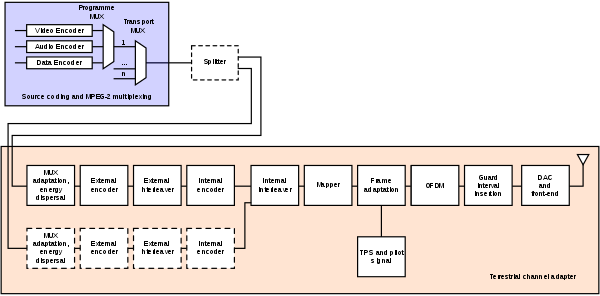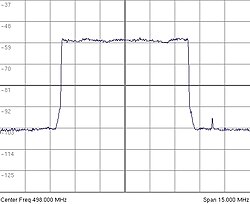DVB-T
DVB-T stands for Digital Video Broadcasting - Terrestrial and it is the DVB European consortium standard for the broadcast transmission of digital terrestrial television. This system transmits a compressed digital audio/video stream, using OFDM modulation with concatenated channel coding (i.e. COFDM). The adopted source coding methods are MPEG-2 and, more recently, H.264.
DVB-T2
In June 2006, a study group named TM-T2 (Technical Module on Next Generation DVB-T) was established by the DVB Group to develop an advanced modulation scheme that could be adopted by a second generation digital terrestrial television standard, to be named DVB-T2.[1]
According to the commercial requirements and call for technologies [2] issued in April 2007, the first phase of DVB-T2 will be devoted to provide optimum reception for stationary (fixed) and portable receivers (i.e., units which can be nomadic, but not fully mobile) using existing aerials, whereas a second and third phase will study methods to deliver higher payloads (with new aerials) and the mobile reception issue. The novel system should provide a minimum 30% increase in payload, under similar channel conditions already used for DVB-T. Expected technologies will probably include:
- LDPC coding, in compliance with the technique already adopted in the DVB-S2 satellite standard;
- MIMO and antenna diversity systems;
- more than 8k carriers (a requirement being to provide a 30% increase in the size of single frequency networks);
- flexible multiplexing;
- variable coding and modulation.
It is expected that work on the DVB-T2 specification will be completed and passed to ETSI for standardization during 2008. First draft standard is expected in the first months of 2008. Market deployment is expected for 2009.
The BBC, ITV, Channel 4 and Five have agreed with the regulator Ofcom to convert one UK multiplex (B, or PSB3) to DVB-T2 to increase capacity for HDTV via DTT.[3] They expect the first TV region to use the new standard will be Granada in November 2009 (with existing switched over regions being changed at the same time). It is expected that by 2017 there will be enough equipment to switch all transmissions to DVB-T2, providing a full HD service on Freeview with archive channels using DVB-T2 to deliver standard-resolution MPEG-4 (part 10) channels.
Technical description of a DVB-T transmitter

With reference to the figure, a short description of the signal processing blocks follows.
- Source coding and MPEG-2 multiplexing (MUX): compressed video, compressed audio, and data streams are multiplexed into PSs (Programme Streams). One or more PSs are joined together into an MPEG-2 TS (MPEG-2 Transport Stream); this is the basic digital stream which is being transmitted and received by home Set Top Boxes (STB). Allowed bitrates for the transported data depend on a number of coding and modulation parameters: it can range from about 5 to about 32 Mbit/s (see the bottom figure for a complete listing).
- Splitter: two different TSs can be transmitted at the same time, using a technique called Hierarchical Transmission. It may be used to transmit, for example, a standard definition SDTV signal and a high definition HDTV signal on the same carrier. Generally, the SDTV signal is more robust than the HDTV one. At the receiver, depending on the quality of the received signal, the STB may be able to decode the HDTV stream or, if signal strength lacks, it can switch to the SDTV one (in this way, all receivers that are in proximity of the transmission site can lock the HDTV signal, whereas all the other ones, even the farthest, may still be able to receive and decode a SDTV signal).
- MUX adaptation and energy dispersal: the MPEG-2 TS is identified as a sequence of data packets, of fixed length (188 bytes). With a technique called energy dispersal, the byte sequence is decorrelated.
- External encoder: a first level of error correction is applied to the transmitted data, using a nonbinary block code, a Reed-Solomon RS (204, 188) code, allowing the correction of up to a maximum of 8 wrong bytes for each 188-byte packet.
- External interleaver: convolutional interleaving is used to rearrange the transmitted data sequence, such way it becomes more rugged to long sequences of errors.
- Internal encoder: a second level of error correction is given by a punctured convolutional code, which is often denoted in STBs menus as FEC (Forward error correction). There are five valid coding rates: 1/2, 2/3, 3/4, 5/6, and 7/8.
- Internal interleaver: data sequence is rearranged again, aiming to reduce the influence of burst errors. This time, a block interleaving technique is adopted, with a pseudo-random assignment scheme (this is really done by two separate interleaving processes, one operating on bits and another one operating on groups of bits).
- Mapper: the digital bit sequence is mapped into a base band modulated sequence of complex symbols. There are three valid modulation schemes: QPSK, 16-QAM, 64-QAM.
- Frame adaptation: the complex symbols are grouped in blocks of constant length (1512, 3024, or 6048 symbols per block). A frame is generated, 68 blocks long, and a superframe is built by 4 frames.
- Pilot and TPS signals: in order to simplify the reception of the signal being transmitted on the terrestrial radio channel, additional signals are inserted in each block. Pilot signals are used during the synchronization and equalization phase, while TPS signals (Transmission Parameters Signalling) send the parameters of the transmitted signal and to unequivocally identify the transmission cell. It should be noted that the receiver must be able to synchronize, equalize, and decode the signal to gain access to the information held by the TPS pilots. Thus, the receiver must know this information beforehand, and the TPS data is only used in special cases, such as changes in the parameters, resynchronizations, etc.

- OFDM Modulation: the sequence of blocks is modulated according to the OFDM technique, using 2048, 4096, or 8192 carriers (2k, 4k, 8k mode, respectively). Increasing the number of carriers does not modify the payload bit rate, which remains constant.
- Guard interval insertion: to decrease receiver complexity, every OFDM block is extended, copying in front of it its own end (cyclic prefix). The width of such guard interval can be 1/32, 1/16, 1/8, or 1/4 that of the original block length. Cyclic prefix is required to operate single frequency networks, where there may exist an ineliminable interference coming from several sites transmitting the same program on the same carrier frequency.
- DAC and front-end: the digital signal is transformed into an analog signal, with a digital-to-analog converter (DAC), and then modulated to radio frequency (VHF, UHF) by the RF front-end. The occupied bandwidth is designed to accommodate each single DVB-T signal into 5, 6, 7, or 8 MHz wide channels. The base band sample rate provided at the DAC input depends on the channel bandwidth: it is samples/s, where is the channel bandwidth expressed in Hz.
| Available bitrates (Mbit/s) for a DVB-T system in 8 MHz channels | |||||
|---|---|---|---|---|---|
| Modulation | Coding rate | Guard interval | |||
| 1/4 | 1/8 | 1/16 | 1/32 | ||
| QPSK | 1/2 | 4.976 | 5.529 | 5.855 | 6.032 |
| 2/3 | 6.635 | 7.373 | 7.806 | 8.043 | |
| 3/4 | 7.465 | 8.294 | 8.782 | 9.048 | |
| 5/6 | 8.294 | 9.216 | 9.758 | 10.053 | |
| 7/8 | 8.709 | 9.676 | 10.246 | 10.556 | |
| 16-QAM | 1/2 | 9.953 | 11.059 | 11.709 | 12.064 |
| 2/3 | 13.271 | 14.745 | 15.612 | 16.086 | |
| 3/4 | 14.929 | 16.588 | 17.564 | 18.096 | |
| 5/6 | 16.588 | 18.431 | 19.516 | 20.107 | |
| 7/8 | 17.418 | 19.353 | 20.491 | 21.112 | |
| 64-QAM | 1/2 | 14.929 | 16.588 | 17.564 | 18.096 |
| 2/3 | 19.906 | 22.118 | 23.419 | 24.128 | |
| 3/4 | 22.394 | 24.882 | 26.346 | 27.144 | |
| 5/6 | 24.882 | 27.647 | 29.273 | 30.160 | |
| 7/8 | 26.126 | 29.029 | 30.737 | 31.668 | |
Technical description of the receiver
The receiving STB adopts techniques which are dual to those ones used in the transmission.
- Front-end and ADC: the analog RF signal is converted to base-band and transformed into a digital signal, using an analog-to-digital converter (ADC).
- Time and frequency synchronization: the digital base band signal is searched to identify the beginning of frames and blocks. Eventual problems on the frequency of the components of the signal are corrected, too. The property that the guard interval at the end of the symbol is placed also at the beginning is exploited to find the beginning of a new OFDM symbol. On the other hand, continual pilots (whose value and position is determined in the standard and thus known by the receiver) determine the frequency offset suffered by the signal. This frequency offset might have been caused by Doppler effect, inaccuracies in either the transmitter or receiver clock, and so on.
- Guard interval disposal: the cyclic prefix is removed.
- OFDM demodulation
- Frequency equalization: the pilot signals equalize the received signal.
- Demapping
- Internal deinterleaving
- Internal decoding: it uses the Viterbi algorithm.
- External deinterleaving
- External decoding
- MUX adaptation
- MPEG-2 demultiplexing and source decoding
Countries and territories using DVB-T [4]
Americas
Europe
 Albania
Albania Andorra
Andorra Austria
Austria Belgium
Belgium Bulgaria (experimental)
Bulgaria (experimental) Croatia
Croatia Czech Republic
Czech Republic Denmark (See DVB-T in Denmark)
Denmark (See DVB-T in Denmark)
 Estonia
Estonia Finland
Finland France
France Germany
Germany Greece
Greece
 Hungary (experimental)
Hungary (experimental) Iceland
Iceland Ireland (See DVB-T in Ireland)
Ireland (See DVB-T in Ireland) Italy
Italy Lithuania
Lithuania Luxembourg
Luxembourg Malta
Malta Montenegro
Montenegro Netherlands
Netherlands Norway
Norway Poland (experimental)
Poland (experimental) Portugal
Portugal Romania
Romania Russia (experimental)
Russia (experimental) Slovakia (experimental)
Slovakia (experimental) Serbia
Serbia Slovenia
Slovenia Spain
Spain Sweden (See DVB-T in Sweden)
Sweden (See DVB-T in Sweden) Switzerland
Switzerland United Kingdom (See DVB-T in United Kingdom).
United Kingdom (See DVB-T in United Kingdom). Ukraine (experimental)
Ukraine (experimental)
Asia/Australasia
 Australia
Australia India
India Indonesia
Indonesia Malaysia (experimental)
Malaysia (experimental) Myanmar
Myanmar New Zealand
New Zealand Philippines (experimental)
Philippines (experimental) Singapore
Singapore Taiwan
Taiwan Vietnam
Vietnam United Arab Emirates
United Arab Emirates
Africa
See also
- ATSC (Advanced Television Systems Committee, North American Standard)
- Digital audio broadcasting (low bitrate video suitable for moving receivers)
- DTV channel protection ratios
- DVB over IP
- Interactive television
- ISDB
- OFDM system comparison table
- Spectral efficiency comparison table
Notes
- ^ TM-T2. Second Generation DVB-T, DVB.org
- ^ http://www.dvb.org/technology/dvbt2/index.xml
- ^ "3 Freeview HD channels will start 2009 - ukfree.tv - independent digital television and switchover advice, since 2002". Retrieved 2007-11-25.
- ^ Official information taken from the DVB website.
References
- ETSI Standard: EN 300 744 V1.5.1, Digital Video Broadcasting (DVB); Framing structure, channel coding and modulation for digital terrestrial television, available at ETSI Publications Download Area (this will open ETSI document search engine, to find the latest version of the document enter a search string; free registration is required to download PDF)


